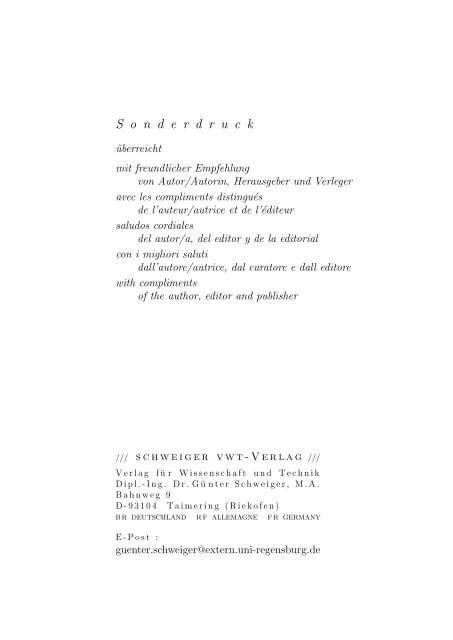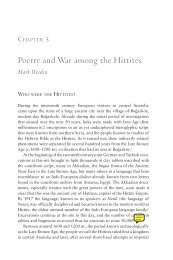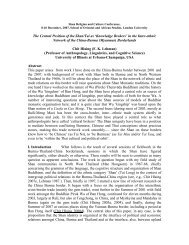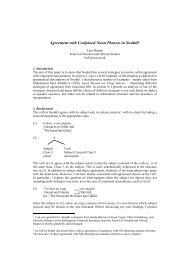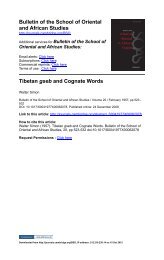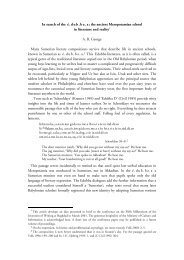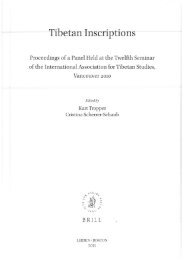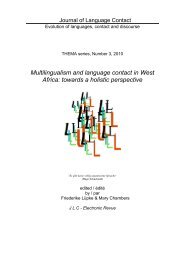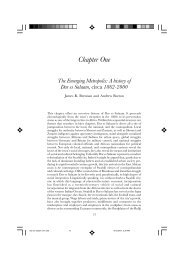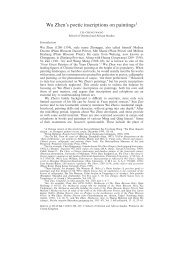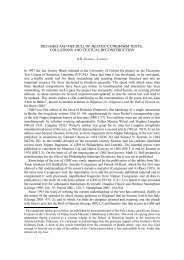Download (316Kb) - SOAS Research Online - The School of ...
Download (316Kb) - SOAS Research Online - The School of ...
Download (316Kb) - SOAS Research Online - The School of ...
You also want an ePaper? Increase the reach of your titles
YUMPU automatically turns print PDFs into web optimized ePapers that Google loves.
S o n d e r d r u c k<br />
überreicht<br />
mit freundlicher Empfehlung<br />
von Autor/Autorin, Herausgeber und Verleger<br />
avec les compliments distingués<br />
de l’auteur/autrice et de l’éditeur<br />
saludos cordiales<br />
del autor/a, del editor y de la editorial<br />
con i migliori saluti<br />
dall’autore/autrice, dal curatore e dall editore<br />
with compliments<br />
<strong>of</strong> the author, editor and publisher<br />
/// s c h w e i g e r v w t - V e r l a g ///<br />
V e r l a g f ü r W i s s e n s c h a f t u n d T e c h n i k<br />
D i p l . - I n g . D r . G ü n t e r S c h w e i g e r , M . A .<br />
B a h n w e g 9<br />
D - 9 3 1 0 4 T a i m e r i n g ( R i e k o f e n )<br />
B R DEUTSCHLAND R F ALLEMAGNE F R GERMANY<br />
E - P o s t :<br />
guenter.schweiger@extern.uni-regensburg.de
INDOGERMANICA<br />
Festschrift Gert Klingenschmitt<br />
indische, iranische und indogermanische<br />
Studien<br />
dem verehrten Jubilar dargebracht zu<br />
seinem fünfundsechzigsten Geburtstag<br />
Herausgegeben von<br />
GÜNTER SCHWEIGER<br />
TAIMERING 2005<br />
schweiger vwt-verlag
Gedruckt mit großzügigen Zuschüssen des Ehepaares Gotō (Pr<strong>of</strong>. Dr. Toshifumi Gotō<br />
und Frau Dr. Junko Gotō, Tohuku Universität in Sendai), Herrn Pr<strong>of</strong>. Dr. Chlodwig<br />
Werba (Universität Wien), des CII (Corpus Inscriptionum Iranicarum, London), des<br />
AIIT (Ancient India and Iran Trust, London), der Kulturabteilung der Botschaft der<br />
Islāmischen Republik Irān, des Kulturreferates der Stadt Regensburg und den Zuwendungen<br />
im Vorwort namentlich genannter finanzieller Förderer.<br />
INDOGERMANICA – Festschrift Gert Klingenschmitt :<br />
Indische, iranische und indogermanische Studien<br />
dem verehrten Jubilar dargebracht zu seinem fünfundsechzigsten Geburtstag /<br />
hrsg. von Günter Schweiger — Taimering (Riek<strong>of</strong>en) : Schweiger VWT, 2005<br />
(Studien zur Iranistik und Indogermanistik ; Bd. 3)<br />
ISBN 3 - 934548 - 01 - 6<br />
NE: Schweiger, Günter [Hrsg.]; Klingenschmitt, Gert; GT<br />
Gedruckt auf säurefreiem und alterungsbeständigem Werkdruckpapier<br />
ISBN 3 - 934548 - 01 - 6<br />
c○ 2005 Schweiger VWT-Verlag<br />
Verlag für Wissenschaft und Technik Taimering (bei Regensburg)<br />
Alle Rechte vorbehalten.<br />
Das Werk einschließlich aller seiner Teile ist urheberrechtlich<br />
geschützt. Jede Verwertung außerhalb der engen Grenzen des<br />
Urheberrechtsgesetzes ist ohne Zustimmung des Verlages<br />
unzulässig und strafbar. Das gilt insbesondere für<br />
Vervielfältigungen, Übersetzungen, Mikroverfilmungen und die<br />
Einspeicherung und Verarbeitung in elektronischen Systemen.<br />
Printed and bound in Germany and the ČR
I N H A L T<br />
VORWORT . . . . . . . . . . . . . . . . . . . . . . . . . . ix<br />
TABULA GRATULATORIA . . . . . . . . . . . . . . . xii<br />
AUFSÄTZE Ignacio-Javier Adiego Lajara, Barcelona<br />
Licio ñ y ˜m . . . . . . . . . . . . . . . . . . . . . . . . . . 1<br />
Agustí Alemany Vilamajó, Barcelona<br />
Some notes on language contacts between Old Ossetic (Alanic)<br />
and Old Turkic . . . . . . . . . . . . . . . . . . . . . . . . 15<br />
Peter Anreiter & Marialuise Haslinger, Innsbruck<br />
Zu den vorrömischen Komponenten des (ost-)alpinen Wortschatzes . . 23<br />
Johnny Cheung, London<br />
Sanskrit meh, míh-, meghá- and niméghamāna- with an excursion<br />
on Persian mih . . . . . . . . . . . . . . . . . . . . . . . . 45<br />
George Dunkel, Zürich<br />
ÑØ und Ô . . . . . . . . . . . . . . . . . . . . . . . . . 57<br />
Heiner Eichner, Wien<br />
Etymologische Notiz zu gotisch iddja und altenglisch eode ‘ging’ aus<br />
sprachgeschichtlicher Sicht . . . . . . . . . . . . . . . . . . . 71<br />
Josef Elfenbein, Cambridge<br />
Taboo . . . . . . . . . . . . . . . . . . . . . . . . . . . . 73<br />
Wolfram Euler, München<br />
Ostbaltisch, Westgermanisch und Britannisch<br />
(Grundsätzliche Überlegungen zur Existenz von Zwischenstufen zwischen<br />
Protosprachen und Einzelsprachen) . . . . . . . . . . . . . . . . 85<br />
Bernhard Forssmann, Erlangen<br />
Zwischen Erde und (zwischen) Himmel . . . . . . . . . . . . . 105<br />
Sonja Fritz, Frankfurt<br />
Der sprachliche Ausdruck von Sozialstrukturen in Südasien . . . . 113<br />
v
vi inhalt<br />
José Luis García Ramón, Köln<br />
Der thessalische Name ËÔÖÓ ×ÔÙÖ ‘Weizen(korn)’: att. ÔÙÖ<br />
und ÔÙÖÓ Ò ‘Weizen(korn) zu Wasser transportieren’ . . . . 127<br />
Badrolzaman Gharīb, Tehrān<br />
<strong>The</strong> shift <strong>of</strong> optative mood (formation) to durative preterite in some<br />
Iranian languages . . . . . . . . . . . . . . . . . . . . . . 145<br />
Jost Gippert, Frankfurt<br />
Armeno – Albanica . . . . . . . . . . . . . . . . . . . . . . 155<br />
Junko Gotō, Sendai<br />
Pāli thīna-middha-, amg.thīn. agiddhi-/thīn. addhi- und<br />
ved. mardh/mrdh<br />
. . . . . . . . . . . . . . . . . . . . . .<br />
˚<br />
Toshifumi Gotō, Sendai<br />
167<br />
Ai. ádbhuta-, ádabdha-, jav.abda-, dapta- und ai. addh ´ā,<br />
aav. ap. azdā . . . . . . . . . . . . . . . . . . . . . . . . . 193<br />
Roberto Gusmani, Udine<br />
‘Ihrzen’ im deutschsprachigen Hochmittelalter . . . . . . . . . . 213<br />
Ivo Hajnal, Innsbruck<br />
Die Flexion der ah2-Stämme im Tocharischen: ererbt oder geneuert? 221<br />
Almut Hintze, London<br />
Indo-Iranian *gar ’to raise al<strong>of</strong>t’ . . . . . . . . . . . . . . . . 247<br />
Michael Janda, Münster<br />
Wanken und Fall der Feinde Mithras: jungavestisch vīϑiˇs- als<br />
Element indoiranischer Dichtersprache . . . . . . . . . . . . . 261<br />
Soon Hwan Jeon, Seoul<br />
Ein typologischer Überblick. Zum Ablaut im Koreanischen:<br />
–mitRücksicht auf deverbale Ableitungen – . . . . . . . . . . . 273<br />
Jean Kellens, Paris<br />
L’amphipolarité sémantique et la démonisation des daivas . . . . . 283<br />
Agnes Korn, Frankfurt<br />
Das Nominalsystem des Balochi, mitteliranisch betrachtet . . . . . 289<br />
Thomas Krisch, Salzburg<br />
Preliminaries to the study <strong>of</strong> adjectival syntax in Proto-Indo-European 303<br />
Martin Joachim Kümmel, Freiburg<br />
Ved. tand- und ein neues indoiranisches Lautgesetz . . . . . . . . 321<br />
Charles de Lamberterie, Paris<br />
Le verbe arménien unim / kalay . . . . . . . . . . . . . . . . 333<br />
Jenny Helena Larsson, Kopenhagen<br />
<strong>The</strong> Orthographic Variants 〈oa〉 and 〈ea〉 – Traces <strong>of</strong> Accent in the<br />
Elbing Vocabulary . . . . . . . . . . . . . . . . . . . . . . 359
inhalt vii<br />
Thomas Lindner, Salzburg<br />
Nominalkomposition im Vulgärlatein und Frühromanischen sowie<br />
ein Plädoyer für die Imperativthese . . . . . . . . . . . . . . . 377<br />
Melanie Malzahn, Wien<br />
Westtocharische Substantive auf -au und einige Fortsetzer von indogermanischen<br />
men-Stämmen im Tocharischen . . . . . . . . . . 389<br />
Javier Martínez García, Oviedo<br />
Laryngeal ending cases and the -n-element in Old Indian declension 409<br />
Joachim Matzinger & Monica Genesin, Jena & Lecce<br />
Nominalkomposition im Missale des Gjon Buzuku . . . . . . . . 413<br />
Michael Meier-Brügger, Berlin<br />
Griechische Präsentien mit Suffixkonglomerat -n¢ié-:<br />
дÒÛ ÔÐ ´ÒÛ; Ö´ÒÛ Ô´ÒÛ; ÒÛ . . . . . . . . . . . . . . . 435<br />
Birgit Anette Olsen, Kopenhagen<br />
<strong>The</strong> development <strong>of</strong> IE *mp and *mbh in Armenian<br />
–Dumézil reconsidered . . . . . . . . . . . . . . . . . . . . 443<br />
Antonio Panaino, Bologna<br />
Yt. 8, 8: stārō krm˚ā? ‘Stelle infuocate’ o ‘Stelle – verme’? . . . . 455<br />
Georges-Jean Pinault, Paris<br />
Analyse étymologique d’un nom de parenté indo-européen . . . . . 465<br />
Robert Plath, Erlangen<br />
apratí- und vergleichbare Bildungen: Zur Genese einer Adjektivklasse<br />
im Rigveda . . . . . . . . . . . . . . . . . . . . . . 487<br />
Heinz Dieter Pohl, Klagenfurt<br />
Überlegungen zum Namen slaw. němsk ‘Deutsch’ . . . . . . . . 505<br />
Jens Elmeg˚ard Rasmussen, Kopenhagen<br />
Zur Herkunft des lateinischen Suffixes -tīvus . . . . . . . . . . 513<br />
Johannes Reinhart, Wien<br />
Altrussisch lz ‘Tuch, Band’ . . . . . . . . . . . . . . . . . 517<br />
Velizar Sadovski, Wien<br />
Dichtersprachliche Stilmittel im Altiranischen und Altindischen . . 521<br />
Stephan Schaffner, Regensburg<br />
Urgerm. *¢urōχ/gi- f. ‘Rüge, Tadel; Anklage’ und *nēχwa- ‘nahe’ . . 541<br />
Klaus T. Schmidt, Saarbrücken<br />
Ex oriente lux III. Zur Vorgeschichte der tocharischen -tk-Präsentien 557<br />
Stefan Schumacher, Wien<br />
Zur Form des gegischen Infinitivs . . . . . . . . . . . . . . . 561<br />
Günter Schweiger, Regensburg<br />
Fragment einer bisher unbekannten ap. Inschrift aus Susa . . . . . 579
viii inhalt<br />
Nicholas Sims-Williams, London &<br />
Elizabeth Tucker, Oxford<br />
Avestan huuōiˇsta and its cognates . . . . . . . . . . . . . . . 587<br />
Marko Snoj, Ljubljana<br />
Zur Bewahrung und weiteren Entwicklung von einigen Fällen der<br />
urindogermanischen Akzentmobilität im Urslawischen . . . . . . 605<br />
Wojciech Sowa, Krakau<br />
Anmerkungen zum Balkanindogermanischen . . . . . . . . . . . 611<br />
David Stifter, Wien<br />
Tocharisch A wä´s´si und wä´s´sitsune . . . . . . . . . . . . . . . 629<br />
Xavier Tremblay, Tournai<br />
Zum Narten-Aorist; Apophonica IV . . . . . . . . . . . . . . 637<br />
Michiel de Vaan, Leiden<br />
<strong>The</strong> reflex <strong>of</strong> intervocalic *b in Avestan . . . . . . . . . . . . . 665<br />
Calvert Watkins, Harvard<br />
Two tokens <strong>of</strong> Indo-Iranian hieratic language . . . . . . . . . . 681<br />
Antje Wendtland, Göttingen<br />
Ist der Satan weiblich? Zur Interpretation von soghdisch xH . . . 689<br />
Chlodwig Werba, Wien<br />
Sanskrit duhitár- und ihre (indo-)iranischen Verwandten . . . . . 699<br />
Michael Witzel, Harvard<br />
Notes on Vedic Dialects, 2. . . . . . . . . . . . . . . . . . . 733<br />
INDIZES<br />
wortindex . . . . . . . . . . . . . . . . . . . . . . . 745<br />
sachindex . . . . . . . . . . . . . . . . . . . . . . . 763<br />
personenindex . . . . . . . . . . . . . . . . . . . . 773<br />
stellenindex . . . . . . . . . . . . . . . . . . . . . 775<br />
SCHRIFTENVERZEICHNIS . . . . . . . . . . . . . . 779
V O R W O R T<br />
SAGT mir, wie habt Ihr gedacht,<br />
wie habt Ihr gesprochen,<br />
habt Ihr so wie wir gelacht,<br />
woher seid Ihr aufgebrochen?<br />
G. Sch.<br />
53 Autoren aus drei Kontinenten haben zu diesem Band ,,Indogermanica“ aktuelle<br />
Ergebnisse aus ihren jeweiligen Forschungsgebieten beigetragen. Ihrem Engagement,<br />
ihrer Mühe und ihrem Vertrauen h<strong>of</strong>fe ich mit diesem Buch zu entsprechen<br />
und danke ihnen herzlich für ihre Beiträge, die aufzeigen, wie reich das<br />
Arbeitsgebiet der Indogermanistik ist. Ihre Untersuchungen sind durchdacht und<br />
komplex, sie geben Anstöße, erschließen Zusammenhänge, sie verlangen eine intensive<br />
Lektüre, die mit der Erkenntnis der Tragweite der Ergebnisse belohnt wird.<br />
Denn da wir Menschen über die Sprache miteinander kommunizieren, ermöglicht<br />
ihre Analyse Erkenntnisse über unsere Herkunft, Entwicklung und Geschichte,<br />
die ihrerseits wiederum vielleicht dazu beitragen können, uns einander besser zu<br />
verstehen, die Kommunikation der Völker auf der Basis eines umfangreicheren<br />
Wissens voneinander zu intensivieren und zu optimieren. So mag der Blick auf<br />
die Vergangenheit eine friedliche Zukunft der universalen Menschheit ermöglichen.<br />
Die mit mathematisch strenger Argumentation im Studiolo gewonnenen Ergebnisse<br />
der Indogermanistik sind jedoch weniger attraktiv und haptisch greifbar wie<br />
die prominent präsentierten Realien ihrer Nachbarwissenschaft, der Archäologie,<br />
die spätestens seit Erkundung der Pharaonengräber eine romantisch-mystische<br />
Schatzgräberaura umweht. Deshalb wird die Indogermanistik öffentlich nicht ihrer<br />
Bedeutung entsprechend rezipiert. In Zeiten kurzlebigen, plakativen und daher<br />
bevorzugt knapp gehaltenen “Infotainments” ist dieses intensive Studium nach<br />
PR- und Marketingkriterien schwer zu vermitteln, erscheint es doch schon den<br />
Wissenschafsministerien als suspektes Orchideenfach, da es nicht nach Rentabilitätsgesichtspunkten<br />
zu evaluieren ist. Rechtfertigungszwänge sind jedoch nach<br />
dem Wissenschaftverständnis im Humboldtschen Sinne nicht vorgesehen. Ohne<br />
in die Defensive oder gar in Resignation zu verfallen, ist zu beklagen, daß der renommierte<br />
Lehrstuhl für Indogermanistik an der Universität Regensburg mit dem<br />
Weggang von Pr<strong>of</strong>. Dr. Gert Klingenschmitt mit dem Wintersemester 2005/2006<br />
seinen Lehrbetrieb einstellen mußte.<br />
Dabei ist die Vergleichende Sprachwissenschaft der Indogermanistik, der Altaistik,<br />
der Semitistik, der Turkologie, Hethitologie, Etruskologie usw. ihrer Aufgabenvielfalt<br />
gewahr. Es gilt, um nur die vorrangigsten Bereiche zu nennen, frühe<br />
ix
almut hintze<br />
INDO-IRANIAN gar ‘TO RAISE ALOFT’<br />
<strong>The</strong> 1 existence <strong>of</strong> an Indo-Iranian set.-root gar ‘to raise (one’s hand or weapon<br />
preparatory to striking)’, an etymological equivalent <strong>of</strong> Greek ÐÐÛ ‘to throw,<br />
hurl, hit’, is disputed in both Avestan and Vedic Studies. Thus, while some<br />
scholars, for instance Mayrh<strong>of</strong>er, EWAia I 470, assume that there is sufficient<br />
evidence for a Vedic root gar i3 ‘ausholen (zum Schlag), aufheben (Waffe)’, a<br />
cognate <strong>of</strong> Avestan gar attested in the form ni-γrāire, others, e. g. Kümmel in<br />
LIV 2 208 n. 1, reject the assumption <strong>of</strong> IIr. cognates <strong>of</strong> Greek ÐÐÛ. In what<br />
follows I propose to examine the Avestan and Vedic evidence for such an IIr. verb.<br />
1. Avestan gar ‘to raise al<strong>of</strong>t’<br />
<strong>The</strong> only Avestan evidence for a root gar ‘to raise (a weapon)’ is the isolated<br />
form ni-γrāire, which occurs only in Yt 10.40 (twice) but, according to Geldner’s<br />
edition (Avesta II 134), without variant manuscript readings. Bartholomae,<br />
AirWb. 512 posits a verb ni-gar ‘to strike down’, <strong>of</strong> which ni-γrāire would be<br />
a 3pl. middle from a present stem grā-. <strong>The</strong> latter would be formed like the<br />
Greek aorist Ð ØÓ. Kellens, Verbe av. 164 rightly objects that Avestan does<br />
not have either present or aorist forms <strong>of</strong> this type. It is more likely, therefore,<br />
that Bailey’s analysis (1956, 97) is correct. He segments the word as ni-γr-āire<br />
(with 3pl. middle ending -āre). 2 Since the ending -āre/-re is primary, niγrāire<br />
can only be the form <strong>of</strong> a root present. 3 With the preverb ni-, Bailey argues, the<br />
verb ni-gar would thus mean ‘to bring (a weapon) down upon’:<br />
Yt 10.40<br />
kartacit aēˇs am hufrāiiuxta<br />
yōi niγrāire<br />
˜<br />
sarahu maˇs. iiākan am<br />
1 I am grateful to Elizabeth Tucker (Oxford) for valuable comments on an earlier draft <strong>of</strong><br />
this article.<br />
2 While Bailey’s alternative segmentation ni-γrā-ire is only possible if the underlying root<br />
ends in a laryngeal, as in the case <strong>of</strong> Grk. ÐÐÛ, it is excluded in his own analysis<br />
because he connects niγrāire with the anit.-root Ved. har ‘to take’. Kümmel, Stativ und<br />
Passivaorist 147 n. 19 rightly comments that one would expect **γar if the underlying<br />
root was set..<br />
3 Although Kellens, Verbe av . 164 classifies the form as belonging to a present in -ā (“à<br />
suffixe rare” with reference to Parth. gr’y- ‘to incline, slide, fall down’, NP girāyistan), he<br />
considers a root present to be more likely in spite <strong>of</strong> the fact that no other evidence for<br />
such a present exists.<br />
247
248 almut hintze<br />
aˇsmnō.janō bauuaiti<br />
yaϑa gran. tō upa.t<br />
˜ biˇstō<br />
apaiti.zan. tō miϑnāiti<br />
miϑrō yō vouru.gaoiiaoitiˇs<br />
vazracit<br />
˜ aēˇs am huniuuixta<br />
yōi niγrāire sarahu maˇs. iiākan am<br />
aˇsmnō.janō bauuaiti<br />
yaϑa gran. tō upa.t<br />
˜ biˇstō<br />
apaiti.zan. tō miϑnāiti<br />
miϑrō yō vouru.gaoiiaoitiˇs<br />
<strong>The</strong>ir very swords, well wielded,<br />
whicharebroughtdownontheheads<strong>of</strong>men,<br />
do not slay with the blade 4<br />
because Mithra <strong>of</strong> wide cattle-pastures,<br />
who has not been acknowledged, remains 5 enraged, provoked.<br />
<strong>The</strong>ir very cudgels, well directed,<br />
whicharebroughtdownontheheads<strong>of</strong>men,<br />
do not slay with the blade<br />
because Mithra <strong>of</strong> wide cattle-pastures,<br />
who has not been acknowledged,<br />
remains enraged, provoked.<br />
<strong>The</strong> Avestan form niγrāire would thus attest a root present <strong>of</strong> gar ‘to raise<br />
(one’s hand or weapon preparatory to striking)’ which, according to Bailey, forms<br />
a reduplicated present jígharti in Vedic. More importantly, he equates the Av.<br />
phrase vazra o ... niγrāire (Yt 10.40) with the Ved. expression vájram ´ā jigharti<br />
(RV 5.48.3) which he translates as ‘he brings the club down upon’. While Grassmann<br />
421 regards jigharti in RV 5.48.3 and 4.17.14 as a present <strong>of</strong> the root ghar<br />
‘to drip, sprinkle’, which here would have the meaning ‘to throw’, Bailey 1956,<br />
98 f. points out the semantic difficulty presented by such divergent meanings and,<br />
taking up Geldner’s earlier suggestion, posits a separate Vedic root ghar, which<br />
would be a variant <strong>of</strong> har ‘to take’. 6<br />
4 If it is accepted that in the course <strong>of</strong> transmission <strong>of</strong> the text metathesis <strong>of</strong> -nm- to<br />
-mn- occurred, possibly under the influence <strong>of</strong> the middle participles’ suffix, then the<br />
first member <strong>of</strong> the compounds aˇsmnō.jan- ‘not slaying with the blade’ and aˇsmnō.vid-<br />
‘not piercing with the blade’ is ˇsanman- ‘blade’. Av.ˇsanman- has been equated by both<br />
Humbach and Henning with Ved. ks.ádman- ‘blade’, see Kellens, Noms-racines 71 f.,<br />
Mayrh<strong>of</strong>er, EWAia I 422 with references.<br />
5 <strong>The</strong> form miϑnāiti belongs to the verb mit ‘to remain, rest’, see Kellens, Verbe av. 177<br />
with n. 11.<br />
6 Geldner, Rig-Veda III 128 ad 10.6.4 d; II 54 ad 5.48.3 b. Bailey 1956, 98 also notes that<br />
Geldner does not refer to Iranian. That Av. gar ‘prendre’ corresponds to Ved. har is also<br />
suggested by Benveniste, Journal Asiatique 225, 1934, 178-180, but the Av. compounds<br />
with aib˘ī, adduced by him, belong to gar ‘to welcome’, see Kellens, Noms-racines 21-27,
indo-iranian gar ‘to raise al<strong>of</strong>t’ 249<br />
Bailey’s equation <strong>of</strong> Ved. ghar ‘to take’ with Av. gar in niγrāire requires the<br />
assumption that the supposed Vedic variant har ‘to take’ begins with either a<br />
pure or labio-velar and that Av. niγrāire is to be separated from both Vedic apagar<br />
i ‘to raise (one’s hand or weapon preparatory to striking)’ and GreekÐÐÛ ‘to<br />
throw, hurl, hit’. A morphological problem, not addressed by Bailey, is posed by<br />
there being both a reduplicated (Ved. jighar-) andarootpresent(Av.niγrāire)<br />
for the same root IIr. *ghar. This is on the basis <strong>of</strong> one example apiece, for<br />
the other instance adduced by Bailey 1956, 96 for Av. gar ‘to take’ belongs<br />
to homonymous gar ‘to welcome’. 7 Furthermore, in the context <strong>of</strong> RV 5.48.3 a<br />
special use <strong>of</strong> jigharti ‘to drip, sprinkle’ would be plausible, because the verb forms<br />
part <strong>of</strong> a metaphor in which the vájra- is a figure for the Soma extracted with<br />
the pressing stones:<br />
RV 5.48.3<br />
´ā gr´āvabhir ahanyèbhir aktúbhir váris.t.ham. vájram ´ā jigharti māyíni /<br />
In the daylight he (the god-fearing man) squirts 8 the choicest mace (i. e. Soma)<br />
down upon the magic one with the pressing stones.<br />
<strong>The</strong> root ghar ‘to drip’ could also underly the form jigharti in RV 4.17.14,<br />
where the object vájra- is probably implied, although there is no reference to any<br />
liquid:<br />
RV 4.17.14<br />
ayám. cakrám is.an. at s ´ūryasya ny éta´sam. rīramat sasrmān.<br />
ám /<br />
´ā kr<br />
˚<br />
˚ s.n. áīm. juhurān. ó jigharti tvacó budhné rájaso asyá yónau //<br />
This one here spun the wheel <strong>of</strong> the sun, he stopped Eta´sa who had sprung forth. 9<br />
Being angry, 10 he “sprinkles” it (i. e. the vajra-) upon the black (horse), on the<br />
bottom <strong>of</strong> the skin, in the lap <strong>of</strong> his aerial world. 11<br />
Narten, YH 88-90. Support for Bailey’s analysis could derive from the use <strong>of</strong> the Vedic<br />
compound pra-har, which according to E. Tichy (in Schaefer, Intensivum 120 n. 332)<br />
is the technical term for threatening with a weapon. However, the two passages referred<br />
to contain rather forms <strong>of</strong> the verb pra-bhar (prá bharā RV 1.61.12, vrtr<br />
´āya prá vadhám.<br />
jabhāra RV 2.30.3 quoted below p. 254).<br />
˚<br />
7 See preceding footnote.<br />
8 Atkins 1950, 36 translates ‘sprinkles, squirts’; Oldenberg, Noten I 345 ‘spritzt er den<br />
trefflichsten Vajra (den Soma)’; Renou 1954, 382: ‘(Indra) throws the vájra on the demon<br />
by sprinkling it (against him)’.<br />
9 <strong>The</strong> form sasr<br />
˚ mān. ám, which is a perfect participle formed with the thematic suffix -māna-,<br />
occurs here instead <strong>of</strong> the expected athematic sasrān. á-, seeNarten 1969, 81 f. (= Kl. Schr.<br />
128), Kümmel, Perfekt 552, 602 (with two different translations <strong>of</strong> the perfect participle).<br />
10 As argued convincingly by Insler 1968, juhurān. ó is a perfect participle from har i ‘to be<br />
angry’ and not, as previously assumed by other scholars, from hvar ‘to go astray, deviate’;<br />
see also Kümmel, Perfekt 602.<br />
11 Translation <strong>of</strong> padas b-d after Insler 1968, 222, who renders jigharti as ‘strikes’.
250 almut hintze<br />
Burrow 1957a, 136 f. objects to Bailey’s supposition <strong>of</strong> a variant ghar on the<br />
grounds that har ‘to take’ forms a perfect jahāra. 12 Instead, he posits another<br />
new root ghar ‘to whirl, brandish, swing (a weapon)’ with a past participle ghūrn. a-<br />
‘whirled, brandished, swung’ 13 for those passages discussed by Bailey where the<br />
meaning <strong>of</strong> ghar, jígharti appears difficult to reconcile with ghar ‘to sprinkle’.<br />
Burrow further objects that Bailey does not account for Ved. gar i ‘to raise (one’s<br />
hand or weapon preparatory to striking)’ which would go very well with Greek<br />
ÐÐÛ and also yield a reasonable equivalent <strong>of</strong> Av. gar in niγrāire. Consequently<br />
he retains the old equation <strong>of</strong> Av. gar in niγrāire with the Vedic verb gar i (gur ),<br />
whose meaning he posits as ‘to propel’.<br />
<strong>The</strong> only alleged Avestan cognate <strong>of</strong> this root, Yt 10.40 niγrāire, is eliminated<br />
by Insler 1967. Elaborating on an earlier suggestion by Windischmann, 14 he<br />
emends niγrāire to x niγnāire, thus retrieving a 3pl. stative <strong>of</strong> the common root<br />
jan ‘to slay’, <strong>of</strong> which a 3sg. stative niγne is attested in Yt 10.104 (= Y 57.29). 15<br />
Insler argues that the transmitted form niγrāire involved a scribal error “due to<br />
the very close orthographic similarity between the signs for r and n in the Avestan<br />
script system” (p. 262). He does not, however, adduce examples <strong>of</strong> the alleged<br />
confusion <strong>of</strong> the signs. Instead, he supports his emendation with a syntactic<br />
argument. In Vedic, the verb ni-han may participate in three different syntactic<br />
figures. In the most common, the weapon utilized is in the accusative as the<br />
object <strong>of</strong> the verb while the person or bodily part struck with the weapon is in<br />
the locative. Since this syntactic construction is also found in Yt 10.40 and 101,<br />
Insler reconstructs an Indo-Iranian expression *ni tásmi vá´zram jhanti ‘he strikes<br />
the cudgel down on him’ (p. 264).<br />
<strong>The</strong> proposal yields a text which is immaculate, syntactically plausible and<br />
with a verbal form fitting well into the paradigm <strong>of</strong> the root jan ‘to slay’. But<br />
perhaps the strongest argument in favour <strong>of</strong> the emendation is, as pointed out<br />
by Insler, ibid. 260 f., the fact that the distribution <strong>of</strong> the old stative ending<br />
-āre/-re is very limited in Avestan. Apart from the disputed form, there are only<br />
o mruuāire from mrū ‘to speak’, sōire (= Ved. ´sére) fromsi ‘to lie’ and ˚āÒh ˘āire<br />
from āh ‘to sit’. 16 While statives <strong>of</strong> these three roots and <strong>of</strong> jan ‘to slay’ are well<br />
documented, such a formation would be difficult to justify for an isolated root gar<br />
‘to raise (one’s hand or weapon preparatory to striking)’ otherwise unattested in<br />
12 Along similar lines, Mayrh<strong>of</strong>er, EWAia II 804 comments that har probably does not<br />
have forms with *ghar.<br />
13 More details on this are given by Mayrh<strong>of</strong>er, EWAia I 515.<br />
14 Windischmann, Mithra 35.<br />
15 A full list <strong>of</strong> references to Insler’s predecessors adopting this interpretation is given by<br />
Kellens, Noms-racines 152 n. 3. <strong>The</strong> emendation is favourably considered by him,<br />
Verbe av. 164, and accepted, for instance, by Kümmel, Stativ und Passivaorist 147 and<br />
in LIV 186 n. 1.<br />
16 H<strong>of</strong>fmann/Forssman p. 203.
indo-iranian gar ‘to raise al<strong>of</strong>t’ 251<br />
Avestan. Insler’s syntactic argument, however, although superficially attractive,<br />
is not quite so compelling because the construction involving the weapon in the<br />
accusative and the object hit in the locative is also found in the case <strong>of</strong> other<br />
roots from this semantic field. For instance, it holds equally well for Bailey’s<br />
Vedic cognate jigharti. More seriously, there is the palaeographic observation,<br />
not addressed by Insler, that the signs n and r are not usually confused. 17 <strong>The</strong><br />
spelling <strong>of</strong> w, n, ‘ and r by the same vertical stroke in the Pahlavi script was<br />
disambiguated by the inventor <strong>of</strong> the Avesta script. While the vertical stroke is<br />
used for n only, r is graphically represented by the letter l <strong>of</strong> the Pahlavi script. 18<br />
As a result, in the extant manuscripts n and r differ distinctively in so far as n<br />
is either a straight or a wavy short vertical stroke while the upper part <strong>of</strong> r slants<br />
upwards to the left and rises well above the main body <strong>of</strong> the text.<br />
A graphic confusion <strong>of</strong> r and n being unlikely, the emendation could be made<br />
plausible with the phonetic argument that x niγnāire was assimilated to niγrāire<br />
during the course <strong>of</strong> oral tradition, possibly under the influence <strong>of</strong> Mithra’s epithet<br />
grantō, which occurs repeatedly in the context <strong>of</strong> the verbal form. 19 <strong>The</strong> postulated<br />
assimilation <strong>of</strong> x niγnāire to niγrāire should have resulted from a Vulgate<br />
pronunciation which at some point entered the manuscript tradition <strong>of</strong> F1’s ancestors.<br />
Such corruption would have happened fairly early in the transmission <strong>of</strong><br />
the text because <strong>of</strong> the consistent spelling with -r- in the manuscripts belonging<br />
to the F1-line. Although Geldner, Avesta II 134 does not record any variant<br />
readings, a manuscript which he did not have at his disposal when editing the<br />
Avesta does yield decisive support to Insler’s emendation: a spelling with -n- is<br />
attested in ms. J 18 <strong>of</strong> J. M. JamaspAsa’s collection, where the reading is niγnāiri<br />
the first time (fol. 138v l. 4) and niγrāira the second (fol. 138v l. 9). Although<br />
J 18, dating from 1827 A. D., is a recent and <strong>of</strong>ten incorrect manuscript, the reading<br />
with -n- is likely to be lectio difficilior because the unique position taken by<br />
J 18 is confirmed by numerous other instances <strong>of</strong> variant readings which suggest<br />
that this manuscript was either influenced by, or even belonged to, a tradition<br />
independent <strong>of</strong> F1. 20 Since all mss. <strong>of</strong> the F1-line transmit the reading with -r-,<br />
17 Cf. also the cautioning comment by Kellens, Noms-racines 152 n. 3. <strong>The</strong>re is, however,<br />
rare evidence for confusion <strong>of</strong> r and n in Yt 15.53, where K40 has vīmrkre whereas<br />
F1 and other mss. have vimankar. Confusion <strong>of</strong> the two signs is assumed by Humbach<br />
1973, 188 in Vd 18.4, where he emends aˇstr am x ainīm for aˇstr am mairīm edited without<br />
variants by Geldner, Avesta III 112.<br />
18 H<strong>of</strong>fmann 1971, 72 (= Aufs. I 324).<br />
19 I owe some clarification <strong>of</strong> this point to a discussion with P. O. Skjærvø.<br />
20 <strong>The</strong> manuscript is described by Hintze, Zamyād-Yaˇst 56 and 1989, 45-48. Another<br />
Khorde Avesta and Yaˇst codex, J19, <strong>of</strong> J. M. JamaspAsa’s collection was equally not<br />
at Geldner’s disposition, but, like J18, was kindly made available to me by Dastur Dr.<br />
K. M. JamaspAsa. Yt 10.40 is on fol. 198r l. 3-7, but unfortunately, the first section from<br />
kartacit to vouru.gaoiiaoitiˇs has been omitted by the scribe. In the second half <strong>of</strong> the<br />
stanza,<br />
˜<br />
beginning with vazracit , the reading <strong>of</strong> the verbal form is corrupt: ne garāre<br />
˜
252 almut hintze<br />
that with -n- must belong to a tradition independent from the F1-line. In view<br />
<strong>of</strong> this new manuscript evidence, on the one hand, and <strong>of</strong> the morphological problems<br />
involved in positing a rare (stative) formation for an otherwise unattested<br />
Avestan root gar, on the other, it seems preferable on balance to accept Insler’s<br />
suggestion. His assertive concluding comment that the emendation <strong>of</strong> niγrāire<br />
to x niγnāire “should be adopted by all those working with Avestan material”<br />
(p. 264), is therefore justified.<br />
Although the emended 3pl. form x niγnāire fits well into the paradigm alongside<br />
a 3sg. stative niγne, the question remains as to why a root with punctualterminative<br />
meaning like jan ‘to hit, slay’ takes stative endings. This problem<br />
is to be seen in connection with the root present formed by Av. jan, Ved.han.<br />
From a theoretical point <strong>of</strong> view, the root present is equally unexpected because<br />
Indo-Iranian action verbs which form athematic root presents usually have stative,<br />
durative or iterative verbal character. García-Ramón 1998, 141, 146 f.<br />
consequently postulates that IE *g wh en, like other action verbs, originally had<br />
durative-iterative verbal character ‘to hit repeatedly’. Under certain circumstances,<br />
the meaning ‘to hit repeatedly’ could become ‘to slay, to kill’. Such an<br />
assumption <strong>of</strong> the root’s durative-iterative verbal character would account for the<br />
forms <strong>of</strong> an athematic root present in both Vedic and Avestan, on the one hand,<br />
and for those with stative endings, attested in Avestan only, on the other. In<br />
Yt 10.40 the syntactic context <strong>of</strong> the stative x niγnāire suggests the meaning ‘(the<br />
swords/maces) are struck repeatedly (on the heads <strong>of</strong> the mortals)’.<br />
2. Vedic gar i ‘to raise al<strong>of</strong>t’<br />
In Vedic, forms which some scholars connect with an IIr. root gar i ‘to raise<br />
(one’s hand or weapon preparatory to striking)’, 21 are considered by others to belong<br />
to the homonymous root gar i (gur) ‘to welcome, honour, praise’. 22 Members<br />
<strong>of</strong> the latter group argue that when compounded with the preverb ápa the root<br />
gar i (gur) acquires the opposite meaning ‘to blame, revile, abuse’, just like the<br />
verb ápa-vad in Vedic Prose. <strong>The</strong> compound apa-gur would therefore denote the<br />
utterance <strong>of</strong> verbal abuse immediately prior to the physical attack.<br />
Yet already the Dhātupāt.ha records a separate root gar i (gur) ‘to raise (a<br />
weapon)’, glossed as udyamane ‘raise al<strong>of</strong>t’, in addition to gar i (gur) ‘to welcome,<br />
honour, praise’ and gar i (gir) ‘to swallow’. Moreover, Sāyan. a comments on<br />
RV 5.32.6 apagūryā: ūrdhvam. vajram udyamya ‘apagūryā (means) having raised<br />
the cudgel’. Schaefer, Intensivum 117 n. 318, 118 suggests that Sāyan. amay<br />
(fol. 198r l. 4). <strong>The</strong> readings <strong>of</strong> J19 <strong>of</strong>ten agree with J10 rather than F1.<br />
21 For instance Geldner, Rig-Veda II 31, Wackernagel/Debrunner 1942, 159 and<br />
Mayrh<strong>of</strong>er, EWAia I 470.<br />
22 For instance by Böhtlingk/Roth, PW II 766 f., Grassmann 402 f., Delbrück, Ai<br />
Syntax 447, and more recently by Schaefer, Intensivum 116-122 whose conclusions are<br />
accepted, for instance, by Kümmel, Stativ und Passivaorist 147 n. 19; LIV 2 208 n. 1.
indo-iranian gar ‘to raise al<strong>of</strong>t’ 253<br />
have based his interpretation on the Dhātupāt.ha gloss and, moreover, may also<br />
have misunderstood it in so far as the true sense <strong>of</strong> the gloss udyamane is ‘to raise<br />
one’s voice’. That is the meaning <strong>of</strong> the verb ud-yam in two Rigvedic passages<br />
where it occurs with the object vácas- ‘word, speech’. Against this view, however,<br />
is the context <strong>of</strong> RV 5.32.6-7, where not only does apa-gur occur but so also does<br />
ud-yam with the clear meaning ‘to raise a weapon’ (vádhar-):<br />
RV 5.32.6<br />
tám. cin mandānó vrs.abháh.<br />
sutásyoccair índro apag ´ūryā jaghāna //<br />
Indra, the bull, intoxicated<br />
˚<br />
by the pressed (Soma), having raised (his arm) al<strong>of</strong>t, 23<br />
slew precisely this one.<br />
RV 5.32.7<br />
úd yád índro mahaté dānav ´āya vádhar yámis.t.a sáho ápratītam /<br />
yád im. vájrasya prábhrtau<br />
dad ´ābha ví´svasya jantór adhamám. cakāra //<br />
When Indra raised his murderous-weapon,<br />
˚<br />
his unopposed force, against the mighty<br />
Dānu-son, when he outwitted him in brandishing the cudgel, he made him the<br />
lowest <strong>of</strong> all creatures.<br />
Stanza 7 clarifies stanza 6 in so far as úd ... vádhar yámis.t.a explains apag ´ūryā,<br />
i. e. in the way that Sāyan. a understood it. Moreover, the passage mentions a trick<br />
used by Indra against his enemy (yád im. vájrasya prábhrtau<br />
dad ´ābha ‘when he<br />
outwitted him in brandishing the cudgel’). Narten convincingly<br />
˚<br />
interprets this<br />
verse as alluding to a special technique employed by Indra when fighting against<br />
Vrtra. ˚ 24 His ploy is referred to as māyā- in other, less explicit passages, such as<br />
RV 1.80.7 and RV 1.32.4:<br />
RV 1.32.4<br />
yád indr ´āhan prathamaj ´ām áhīnām ´ān māyínām ámināh. prótá māy ´āh. /<br />
When you, O Indra, slew the first-born <strong>of</strong> the dragons, then you outwitted even<br />
the deceptions <strong>of</strong> the deceitful ones.<br />
<strong>The</strong> same device further used by Indra against his enemy is also referred to in<br />
the context <strong>of</strong> the second attestation <strong>of</strong> apa-gur in RV 5.29.4:<br />
RV 5.29.4<br />
´ād ródasī vitarám. vís.kabhāyat sam. vivyāná´s cid bhiyáse mrgám.<br />
kah. /<br />
jígartim índro apajárgurān. ah. práti ´svasántam áva dānavám.<br />
˚<br />
han //<br />
<strong>The</strong>n he stemmed heaven and earth apart. Having cloaked himself he frightened<br />
the wild animal. Indra, raising (his arm), slew the voracious, hissing Dānu-son.<br />
23 Schaefer, Intensivum 116 interprets uccaih. as ‘loud’ which would characterize a verbum<br />
dicendi. However, in the Sa ˙mhitās (here and in the Atharva Veda) the form has the local<br />
meaning ‘high’, the metaphorical use ‘loud’ being attested only from Vedic Prose onwards.<br />
24 Narten 1988-90, 148 n. 14 (= Kl.Schr. 386). On the practice <strong>of</strong> deception or trickery<br />
as applied in combat, see Insler 1969, 23-24, where the relevant expression in RV 5.32.7<br />
is translated as ‘when he tricked him into the impact <strong>of</strong> the cudgel’. On pra-bhar as a<br />
technical term for threatening with a weapon, see above p. 3 n. 6.
254 almut hintze<br />
<strong>The</strong> perfect participle sam. vivyānáh. ‘having cloaked himself’ describes the trick<br />
whichIndrausedt<strong>of</strong>rightenVrtra. More details are found in RV 2.30.3:<br />
˚<br />
RV 2.30.3<br />
ūrdhvó hyásthād ádhy antáriks.é ’dhā vrtr<br />
´āya prá vadhám. jabhāra /<br />
míham. vásāna úpa h´īm ádudrot tigm ´āyudho<br />
˚<br />
ajayac chátrum índrah. //<br />
For he stood upright in the sky and thrust his murderous-weapon at Vrtra. En-<br />
˚<br />
veloping himself in a cloud he had run up to him. Having a sharp weapon, Indra<br />
defeated the enemy.<br />
Geldner, Rig-Veda I 313 interprets míham. vásānah. ‘enveloping himself in a<br />
cloud’ as referring to a ploy by Vrtra.<br />
However, apart from the awkward change<br />
<strong>of</strong> subject that this involves, RV<br />
˚<br />
5.29.4 sam. vivyānáh. confirms that it was Indra<br />
who was cloaked in a cloud while approaching the serpent in order to slay it. It<br />
is in this situation that the verb apa-gur occurs, immediately preceding Indra’s<br />
action <strong>of</strong> ‘slaying’ (han) the serpent.<br />
In any case, the passages quoted suggest that Indra employed a physical trick<br />
rather than a verbal one – as would be implied if apa-gur meant ‘to revile, abuse’<br />
– in the situation immediately preceding the act <strong>of</strong> slaying. Moreover, none <strong>of</strong><br />
the innumerable allusions in the RV to his great feat mentions that the god made<br />
an insulting speech before slaying the serpent. In its two Rigvedic attestations<br />
(RV 5.29.4 and 5.32.6), apa-gur occurs as an absolutive and a participle respectively,<br />
without object but qualifying the verb han in both instances. <strong>The</strong> syntactic<br />
context suggests that the action denoted by apa-gur immediately precedes, and<br />
forms part <strong>of</strong>, that expressed by the verb han.<br />
Not only in the Rigveda but also in Vedic Prose forms <strong>of</strong> apa-gur occur in the<br />
textual vicinity <strong>of</strong> the verb han ‘to slay’. From the Taittirīya Sa ˙mhitā onwards,<br />
forms <strong>of</strong> gur with prefixes apa, ava and ud appear particularly in legal contexts<br />
where apa-gur denotes an action immediately preceding a physical attack. It<br />
describes the first <strong>of</strong> three stages by which one person inflicts bodily injury on<br />
another with a weapon. <strong>The</strong> verbs characterizing the different stages are ápa-gur<br />
for the one before the attack, ní-han ‘to strike down’ for the second stage referring<br />
to the blow with a weapon, and finally lohitam. kr ‘to shed blood’, describing the<br />
effects <strong>of</strong> the blow.<br />
˚ 25<br />
A comparable distinction is also found in Zoroastrian law where special terms for<br />
various <strong>of</strong>fences, defined in Vd 4.17-43, N 42 and FiO 25b (= Klingenschmitt,<br />
FiO § 699-704), form part <strong>of</strong> its legal terminology. While there are some differences<br />
between the lists <strong>of</strong> the Videvdad and that <strong>of</strong> the Farhang-ī ōīm, the latter<br />
enumerates six <strong>of</strong>fences in order <strong>of</strong> increasing gravity. <strong>The</strong> Middle Persian terms<br />
are āgrift, ōiriˇst, arduˇs, xwar, bāzā-zaniˇsnīh and yād. All concern physical attack<br />
and any possible injury resulting therefrom. <strong>The</strong> mildest one, āgrift (’glpt,<br />
25 <strong>The</strong> relevant passages are quoted by Oertel, 1931, 287 f.; Burrow 1957 b, 9-11; Schaefer,<br />
Intensivum 117 f.
indo-iranian gar ‘to raise al<strong>of</strong>t’ 255<br />
Av. āgrpta- from ā-grab ‘to seize’), is committed by rising up to grasp a<br />
weapon (snaϑm ushiˇstaiti Vd 4.17) with the intention <strong>of</strong> hitting an innocent<br />
person (Klingenschmitt § 699, Vd 4.18-21). <strong>The</strong> second, ōiriˇst ( + ’wwylˇst, Av.<br />
auuaoiriˇsta- from auua-uruuaēs ‘to turn (a weapon) towards, against someone’,<br />
AirWb. 168 f.) denotes the <strong>of</strong>fence <strong>of</strong> wielding a weapon against such a one<br />
(FiO § 700, Vd 4.21-25). <strong>The</strong> Videvdad explains that one attacks (yat<br />
˜ fraˇsusaiti<br />
Vd 4.17) with a weapon turned against another person (auua-uruuaēs ). <strong>The</strong> third,<br />
Av. arduˇs-,MParduˇs (’ldwˇs ), applies when one actually hits another person with<br />
a weapon with the intention <strong>of</strong> inflicting an injury (aēnō.manaÒha paiti.aˇsnaoiti<br />
Vd 4.17) but without causing a visible wound (FiO § 701, ardusa snaϑa jain. ti<br />
Vd 4.26, 29). As suggested by Bartholomae, AirWb. 194, the noun ardusbelongs<br />
with the Vedic verb ard, the meaning <strong>of</strong> which was established by Gotō<br />
as ‘to stagger, lurch, flounder’. 26 Both the Vedic cognate and the position taken<br />
by the Av. term arduˇs- in the hierarchy <strong>of</strong> physical attacks suggest that arduˇssnaϑa-<br />
denotes a stroke which causes the victim to shake and lose balance but<br />
without being visibly wounded (x v ara-).<br />
<strong>The</strong> fourth <strong>of</strong>fence entails a visible injury, x v ara- (FiO 702), <strong>of</strong> which the Videvdad<br />
distinguishes three types. One does not bleed (yō narm vīxrūmn. tm<br />
x v arm jain. ti ‘the one who strikes a man a wound that does not bleed’ Vd 4.30,<br />
33), the second does (tacat<br />
˜ .vohunīm x v arm jain. ti ‘he strikes a wound characterized<br />
by running blood’ Vd 4.34, 36) and the third one results in a broken bone<br />
(astō.biδm x v arm jain. ti ‘he strikes a wound characterized by a broken bone’<br />
Vd 4.37, 39). Of the latter, the FiO distinguishes two types. As convincingly<br />
argued by Gert Klingenschmitt, the specific case <strong>of</strong> hitting and injuring someone’s<br />
arm is called bāzujata- in Av. and rendered into Pahlavi as b’c’y znˇsnyh (bāzāzaniˇsnīh,<br />
also written b’c’y MH. YTWN-ˇsnyh, Klingenschmitt § 703 with n. 2,<br />
N 42), while the other one, Av. yāta-, Pahl.y’t lwbˇsn /yād rawiˇsn/, entails doing<br />
the same to someone’s leg (§ 704, N 42). <strong>The</strong> fifth and final <strong>of</strong>fence is a fatal stroke<br />
(frazābaoδaÒhm snaϑm jain. ti ’he strikes a fatal stroke’ Vd 4.40, 43). 27<br />
26 2 Gotō, I. Präsensklasse 102-104 and 1993, 119 f., cf. also LIV 223f. <strong>The</strong> Vedic causative<br />
ardáya- ‘make shake violently, set in violent motion, shake to pieces’ appears both with<br />
vrtrám<br />
and the demons destroyed by Indra as direct objects, see Jamison, áya-Formations<br />
107<br />
˚<br />
with n. 2, Gotō, I. Präsensklasse 104. Accordingly, arduˇs- is a derivative with suffix<br />
-uˇs- from the root ard ‘to shake’. <strong>The</strong> suffix -uˇs- attached directly to the root has the<br />
same function as -as- and denotes the carrying out <strong>of</strong> the action expressed by the verbal<br />
root (AiGr. II 2 pp. 229, 489). In the expression arduˇs- snaϑa- the syntactic relationship<br />
between the two nouns is that <strong>of</strong> an apposition if arduˇs- is a substantive. Alternatively,<br />
arduˇs- could also function as an adjective, cf. on adjectives in -us.- AiGr. II 2 p. 490 f.<br />
27 According to Bartholomae 1899, 6 n. 1 and AirWb. 1005 n. 3, fra-zā- in frazā-baoδahstands<br />
for fra-zyā- and comes from zyā ‘to harm’, thus also Duchesne-Guillemin, Composés<br />
72. It is more likely, however, that the compound contains the root zā ‘to leave<br />
behind’. <strong>The</strong> Ved. equivalent hā forms a compound fra-hā ‘to leave, desert, abandon,<br />
quit’ and a feminine root noun prah ´ā- which occurs as a technical gambling term denoting<br />
an ‘advantage’, but whose precise meaning is difficult to determine, see Scarlata,
256 almut hintze<br />
Although different vocabularies are used in Iranian and Vedic, the first two<br />
stages <strong>of</strong> the Zoroastrian system, preceding the actual attack and denoted by<br />
Av. āgrpta- (Pahl. āgrift )andauuaoiriˇsta- (Pahl. ōiriˇst ) respectively, resemble<br />
apa-gur in Vedic law. Av. arduˇs- (Pahl. arduˇs ) and the blow to produce a<br />
non-bleeding wound, Av. vīxrūman. t- x v ara-, correspond to the Vedic second stage<br />
denoted by ni-han ‘to strike down’, while the varieties <strong>of</strong> Av. x v ara- (Pahl. xwar )<br />
involving blood as well as the ‘fatal blow’, Av. frazābaoδah- snaϑa-, agree with<br />
Vedic lohitam. kr<br />
˚ ‘to shed blood’. <strong>The</strong> Vedic and Avestan correspondences are<br />
summarized in the following table:<br />
Types <strong>of</strong> physical injury in Vedic and Avestan<br />
Stage Offence Vedic Avestan<br />
One: Seizing a weapon apa-gur ‘to raise āgrpta- seize a weapon<br />
Preparing for with the intention (one’s hand or<br />
an assault <strong>of</strong> physical attack weapon preparatory auuaoiriˇsta- turn a<br />
to striking)’ weapon against a person<br />
Two: Hitting a person ni-han arduˇs- snaϑa-<br />
Carrying out an with a weapon ‘to strike down’ a stroke which causes<br />
assault without but without the person hit to<br />
shedding blood shedding any blood shake and lose balance<br />
x v ara- vīxrūman. t- a<br />
non-bleeding injury<br />
Three: Hitting a person lohitam. kr<br />
˚<br />
xv Carrying out with a weapon so ‘to shed blood’<br />
ara- tacat.vohunīm<br />
a bleeding<br />
˜<br />
injury<br />
an assault with as to shed blood<br />
shedding blood xvara- astō.bid- injury<br />
resulting in fracture:<br />
1.bāzujata- <strong>of</strong> the arm<br />
2.yāta- <strong>of</strong> the leg<br />
frazābaoδah- snaϑaa<br />
fatal stroke<br />
As in the Rig-Vedic passages, in Vedic Prose the action denoted by apa-gur<br />
immediately precedes that expressed by the verb han. That such action consists<br />
in raising one’s arm in preparation for a stroke is suggested by the position taken<br />
by Ved. apa-gur in the classification <strong>of</strong> physical injuries. Like Av. āgrpta- and<br />
Wurzelkomposita 698-700. As an exocentric compound and an epithet <strong>of</strong> a blow or strike<br />
(snaϑa-), the literal meaning <strong>of</strong> frazābaoδah- is ‘characterized by leaving perception’. That<br />
perception (baoδah-) leaves the body at the moment <strong>of</strong> death, is stated in Vd 7.2 iˇsar pasca<br />
para.iristīm ... us haca baoδō aiiāt ‘immediately after death ... perception will go away<br />
from (the body).’<br />
˜
indo-iranian gar ‘to raise al<strong>of</strong>t’ 257<br />
auuaoiriˇsta-, it denotes the handling <strong>of</strong> a weapon in preparation for a physical<br />
attack.<br />
3. Conclusion<br />
This investigation shows that while the alleged Avestan evidence for gar ‘to<br />
raise (one’s hand or weapon preparatory to striking)’ has to be abandoned, forms<br />
<strong>of</strong> this root are attested in Vedic. <strong>The</strong>re remains, however, the semantic problem<br />
<strong>of</strong> how to reconcile the meaning <strong>of</strong> Vedic gar with that <strong>of</strong> Greek ÐÐÛ. <strong>The</strong> latter<br />
refers to ‘hitting by throwing’ using a weapon such as a spear, stone or arrow28 while, as rightly pointed out by Kellens, Noms-racines 151 n. 3, the cudgel is a<br />
weapon which is not thrown but held in the hand when striking an enemy. Yet in<br />
spite <strong>of</strong> their different use, Vedic gar and Greek ÐÐÛ are semantically close since<br />
both describe aspects <strong>of</strong> an action aimed at hitting an enemy with a weapon either<br />
held in or released from the hand. If the two verbs are etymologically related, the<br />
older Greek application would be that <strong>of</strong> hitting by throwing a weapon such as a<br />
spear or a stone, while the shooting <strong>of</strong> an arrow would be a later use. In order<br />
to achieve the maximum impact <strong>of</strong> the weapon thrown – at least as far as spear<br />
and stone are concerned – the aggressor has to raise his arm forcefully and aim<br />
precisely. This part <strong>of</strong> the action, which is essential and decisive for its success,<br />
is denoted in Vedic by gar, reinforced by the preverb apa ‘away’. <strong>The</strong> path <strong>of</strong><br />
the weapon from the aggressor’s hand to the enemy remains outside his control<br />
regardless <strong>of</strong> whether the weapon is hurled through the air or forcefully struck<br />
down on the victim while being held in the hand. In both forms <strong>of</strong> aggression, the<br />
success <strong>of</strong> the blow entirely depends on the preparatory stage <strong>of</strong> raising the arm<br />
and aiming precisely. Such stage is highlighted by the Vedic verb apa-gur, while<br />
the meaning <strong>of</strong> Greek ÐÐÛ focuses on the success <strong>of</strong> the action when the victim<br />
is hit.<br />
It may therefore be suggested that in IE the root *g w elh1 denoted the action<br />
<strong>of</strong> raising an arm with a weapon in one’s hand in order to hit an enemy. <strong>The</strong><br />
weapon could either be used to strike the victim while being retained in the<br />
aggressor’s hand or released and thrown through the air. In Greek, a semantic<br />
specialization took place in which the meaning was narrowed down to hitting an<br />
enemy with a weapon thrown at them. In Vedic the verb has become obsolete,<br />
presumably because <strong>of</strong> pressure from the homonymous roots gar ‘to welcome’ and<br />
gar ‘to swallow’. <strong>The</strong> verb in its original meaning survives only in two Rigvedic<br />
attestations and later as a legal technical term denoting, like its antecedent in the<br />
Rigveda, the forceful raising <strong>of</strong> one’s arm preparatory to striking with a weapon.<br />
28 Tichy 1979, 201 f.; Schaefer, Intensivum 119 with references.
258 almut hintze<br />
References<br />
Atkins 1950 : S. D. Atkins, “<strong>The</strong> Meaning <strong>of</strong> Vedic aktú.” Journal <strong>of</strong> the American<br />
Oriental Society 70, 24-40.<br />
AiGr. see: Wackernagel(/Debrunner).<br />
Bailey 1956 : H. W. Bailey, “Armeno-Indoiranica.” Transactions <strong>of</strong> the Philological<br />
Society, 88-126.<br />
Bartholomae AirWb. : Chr. Bartholomae, Altiranisches Wörterbuch. Straßburg:<br />
Trübner, 1904, repr. Berlin/New York: de Gruyter, 1979.<br />
Bartholomae 1899 : Chr. Bartholomae, “Arica IX.” Indogermanische Forschungen<br />
10, 1-20.<br />
Böhtlingk/Roth PW : O. Böhtlingk/R. Roth, Sanskrit Wörterbuch. Herausgegeben<br />
von der Kaiserlichen Akademie der Wissenschaften. St Petersburg 1855-1875,<br />
reprint 1966.<br />
Burrow 1957 a : Th. Burrow, “Sanskrit g¯r /gur ’to welcome’.” Bulletin <strong>of</strong> the <strong>School</strong><br />
<strong>of</strong> Oriental and African Studies 20 (=<br />
˚<br />
Fs Sir Ralph TURNER ), 133-144.<br />
Burrow 1957 b : Th. Burrow, “Nirvacanāni.” Annals <strong>of</strong> Oriental <strong>Research</strong>, University<br />
<strong>of</strong> Madras 13, Sect. 5, 4-13.<br />
Delbrück Ai Syntax :B.Delbrück, Altindische Syntax. Halle 1888 (Syntaktische<br />
Forschungen 5), reprint Darmstadt: Wiss. Buchgesellschaft, 1976.<br />
Duchesne-Guillemin Composés : J. Duchesne-Guillemin, Les composés de l’Avesta.<br />
Liège: Faculté de Philosophie et Lettres, 1936 (Bibliothèque de la Faculté de<br />
Philosophie et Lettres de l’Université deLiège, 74).<br />
EWAia see : Mayrh<strong>of</strong>er, EWAia.<br />
García-Ramón 1998 : J. L. García-Ramón, “Indogermanisch *g ¢uhen- ‘(wiederholt)<br />
schlagen’, ‘töten’.” In: J. Jasan<strong>of</strong>f, H.CraigMelchert and Lisi Oliver<br />
(eds.), Mír Curad. Studies in Honor <strong>of</strong> Calvert WATKINS. Innsbruck: Institut für<br />
Sprachwissenschaft, 139-154.<br />
Geldner, Avesta : K. F. Geldner, Avesta. <strong>The</strong> sacred books <strong>of</strong> the Parsis. 3 vols.,<br />
Stuttgart: Kohlhammer, 1896. 1889. 1896.<br />
Geldner, Rig-Veda : K. F. Geldner, Der Rig-Veda aus dem Sanskrit ins Deutsche übersetzt.<br />
3 Bde., Cambridge, Mass., 1951 (= Harvard Oriental Series 33-35).<br />
Gershevitch, Mithra : I. Gershevitch, <strong>The</strong> Avestan Hymn to Mithra. WithanIntroduction,<br />
Translation and Commentary. Cambridge: CUP, 1959, repr. 1967.<br />
Gotō, I. Präsensklasse : T. Gotō, Die I. Präsensklasse im Vedischen. Untersuchungen<br />
der vollstufigen thematischen Wurzelpräsentia. Wien: Österr. Akademie der<br />
Wissenschaften, 1987 (SbÖAW 489).<br />
Gotō 1993 : T. Gotō, “Materialien zu einer Liste altindischer Verbalformen, Nr. 8-15.”<br />
Bulletin <strong>of</strong> the National Museum <strong>of</strong> Ethnology 18, no. 1, 119-141.<br />
Grassmann : H. Grassmann, Wörterbuch zum Rig-Veda. Leipzig 1893, reprint Wiesbaden:<br />
Harrassowitz, 1964, 6th revised edition 1996.<br />
Hintze, Zamyād-Yaˇst A. Hintze, Der Zamyād-Yaˇst. Edition, Übersetzung, Kommentar.<br />
Wiesbaden: Reichert 1994 (Beitäge zur Iranistik 15).
indo-iranian gar ‘to raise al<strong>of</strong>t’ 259<br />
Hintze 1989 : A. Hintze, “F1, E1 und drei neue Yaˇst-Handschriften”. Münchener<br />
Studien zur Sprachwissenschaft 50, 31-50.<br />
H<strong>of</strong>fmann, Aufs. : K. H<strong>of</strong>fmann, Aufsätze zur Indoiranistik. 3 vols., Wiesbaden: Reichert,<br />
1975. 1976. 1992.<br />
H<strong>of</strong>fmann 1971 : K. H<strong>of</strong>fmann, “Zum Zeicheninventar der Avesta-Schrift.” In: W.<br />
Eilers (ed.), Festgabe Deutscher Iranisten zur 2500 Jahrfeier Irans. Stuttgart:<br />
Hochwacht (= Aufs. I 316-326).<br />
H<strong>of</strong>fmann/Forssman : K. H<strong>of</strong>fmann/B. Forssman, Avestische Laut- und Formenlehre.<br />
Innsbruck: Institut für Sprachwissenschaft, 1996 (IBS 84).<br />
Humbach 1973 : H. Humbach, “Beobachtungen zur Überlieferungsgeschichte des Awesta.”<br />
Münchener Studien zur Sprachwissenschaft 31, 109-122.<br />
Insler 1967 : St. Insler, “Avestan niγrāire.” Zeitschrift für Vergleichende Sprachforschung<br />
auf dem Gebiete der indogermanischen Sprachen 81, 259-264.<br />
Insler 1968 : St. Insler, “Vedic juhuras, juhūrthās, juhuranta and juhurān. á-.” Journal<br />
<strong>of</strong> the American Oriental Society 88, 1968, 219-223.<br />
Insler 1969 : St. Insler, “Vedic dambháyati.” Indogermanische Forschungen 74, 13-31.<br />
Jamison, -áya-Formations : St.W. Jamison, Function and Form in the -áya-Formations<br />
<strong>of</strong> the Rig Veda and Atharva Veda. Göttingen: Vandenhoeck & Ruprecht,<br />
1983 (Ergänzungsheft zur Zeitschrift für Vergleichende Sprachforschung 31).<br />
Kellens, Noms-racines : J. Kellens, Les noms-racines de l’Avesta. Wiesbaden: Reichert,<br />
1974.<br />
Kellens, Verbe av. : J. Kellens, Le verbe avestique. Wiesbaden: Reichert, 1984.<br />
Klingenschmitt, FiO : G. Klingenschmitt, Farhang-i ōīm. Edition und Kommentar.<br />
(Unpublished PhD dissertation). Erlangen 1968.<br />
Kümmel, Perfekt :M.J.Kümmel, Das Perfekt im Indoiranischen. Eine Untersuchung<br />
der Form und Funktion einer ererbten Kategorie des Verbums und ihrer Weiterentwicklung<br />
in den altindoiranischen Sprachen. Wiesbaden: Reichert, 2000.<br />
Kümmel, Stativ und Passivaorist M. J. Kümmel, Stativ und Passivaorist im Indoiranischen.<br />
Göttingen: Vandenhoeck & Ruprecht, 1996 (Historische Spachforschung,<br />
Ergänzungsheft 39).<br />
LIV 2 : H. Rix et alii, Lexikon der indogermanischen Verben. Die Wurzeln und ihre<br />
Primärstammbildungen. Wiesbaden: Reichert, 1998, 2., erw. und verb. Aufl.<br />
2001.<br />
Mayrh<strong>of</strong>er, EWAia :M.Mayrh<strong>of</strong>er,Etymologisches Wörterbuch des Altindoarischen.<br />
Heidelberg: Winter, vol. I 1992, vol. II 1996, vol. III 1997 ff.<br />
Narten, Kl. Schr. :J.Narten,Kleine Schriften. Ed. by M. Albino and M. Fritz.<br />
Wiesbaden: Reichert, 1995.<br />
Narten, YH :J.Narten,DerYasna HaptaÒhāiti. Wiesbaden: Reichert, 1986.<br />
Narten 1969 : J. Narten, “Ai. sr in synchronischer und diachronischer Sicht.” Münchener<br />
Studien zur Sprachwissenschaft<br />
˚<br />
26, 77-103 (= Kl. Schr. 125-143).<br />
Narten 1988-90 : J. “Die vedischen Verbalwurzeln dambh und dabh.” Die Sprache 34,<br />
142-157 (= Kl. Schr. 380-395).


